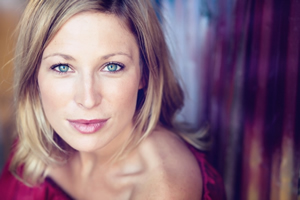The Japan-born dance duo Eiko and Koma returned to Reynolds Theater Monday night with a world premiere marking a new chapter in their lives as dance-makers. This work, the eleventh commissioned by the American Dance Festival (which honored them with the Scripps Award for Lifetime Achievement three years ago), tests whether the pair’s unique theatrical “delicious movement” style can be expanded to include dancers besides themselves.
In recent years, Eiko and Koma have been working with young Cambodian artists and dancers, and “Quartet” features two of these, the 17-year-old Charian and the 18-year-old Peace, dancing along with Eiko and Koma before a backdrop of four very large stylized figurative paintings by other Cambodian students. As in all of Eiko and Koma’s works, the movements are very, very slow — so slow that often you do not realize that metamorphosis is occurring until everything has completely changed. The effect is quite magical and often leads the viewer to moments of enlightenment.
With four dancers, far more permutations of movement and meaning are possible than with two, and it was thrilling to see those relational possibilities unfold and very moving to see the contrast between the bodies of the two pairs. Eiko and Koma have been dancing for 35 years, and their bodies are very beautiful — pliant, strong and supremely controlled — but they are not young. Under the white body paint that gives them the presence of messengers from the spirit world, those bodies radiate a wisdom that can only come from experience. Charian and Peace, on the other hand, are young, and they radiate the sublime beauty of unwearied youth. Their lovely brown skin glows as if lit from within, and the contrast with the white matte coloration of the older dancers makes the sense of time’s passage almost unbearably poignant during the shifting images of parents, children, lovers, apprentices, guides.
Saying what happens in an Eiko and Koma dance is pretty nearly impossible. They are thoroughly non-verbal. You understand them viscerally and imagistically. Words seem even blunter than usual as you watch the dancers move and, as the pieces progress, the mind’s constant commentary finally calms itself. You come out of this meditative state with a greater understanding of deep things. Watching Eiko and Koma can be a truly profound experience.
The first time I saw “Grain,” in 1984, was that way. It was a life-altering experience. Food, water, sex — the life force put on stage, aestheticized but unmasked — I could hardly believe my eyes. If I had to list my top five lifetime encounters with art, Eiko and Koma performing “Grain” would be on it, right up there with seeing Martha Graham raise her arms and invoke all the forces of the universe.
“Grain” as performed by Charian and Peace did not have the same impact. Though graceful and very talented, these young dancers do not yet have the force to make a soul-shaking work like the one I remember so vividly. The tone of the work is very different in this recreation. There is more light, and more clothing — and no otherworldly white body paint. However, it is still a powerful piece, and at times you could glimpse the yet untapped forces of the dancers. When Charian suddenly tosses a fistful of hard rice into the air, when Peace turns back towards the light with the altar/tray of soft cooked rice studded with candles — you can see that they know things that one day they will be able to fully express.
Whether Eiko and Koma’s oeuvre can successfully be preserved after their ability to perform their works has ceased remains an open question. They had never before set their choreography on others; this is a first experiment. It would be wonderful for future generations to see these works…, but it may be that they exist, like bodies, for a short time only. If that is the case, it would be foolish to miss an opportunity to see these particular creative bodies.











